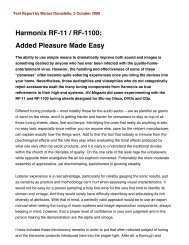Reimyo CAT-777 MK II and KAP-777 [pdf] - Harmonix by Combak
Reimyo CAT-777 MK II and KAP-777 [pdf] - Harmonix by Combak
Reimyo CAT-777 MK II and KAP-777 [pdf] - Harmonix by Combak
- No tags were found...
Create successful ePaper yourself
Turn your PDF publications into a flip-book with our unique Google optimized e-Paper software.
have been “twisted <strong>and</strong> turned” <strong>by</strong> theuse of circuitry. After all, I have heardmy share of tube-like solid-state poweramplifiers. One of the big things Imissed with these was transparency, asthey all seemed faintly opaque sounding.On the other h<strong>and</strong>, <strong>and</strong> when fullypushed, the JA 80s don’t sound“tubular,” but neutral at best. Here onehas simply arrived at an almost identical<strong>and</strong> pristine ideal in terms of sound. Butwait! The associated <strong>Harmonix</strong> powercord has not yet been connected.And the manner in which the <strong>KAP</strong>-<strong>777</strong> captures the musical structure ofGustav Leonhardt’s Zell harpsichord,through which the unleashed energy ofthis – Bach’s perhaps most unconstrained– composition fascinates <strong>by</strong>how closely it approaches the free reinof Miles Davis’ creative power (acrossthe centuries, so to speak), is just asastonishing with this <strong>Reimyo</strong> as are thisdevice’s sonic capabilities. Finally, thepower cord has been replaced with theXDC-350M2R, which is included withthe amplifier that was designed to use it.And sure enough: now that last iota ofimmediacy is also there <strong>and</strong>, which indirect comparison, sounds even morenatural than before. Although thisdistinction – one that can be bothdescribed <strong>and</strong> objectified – may notseem very significant when taking aquick listen, it does set off aphenomenon that may prove addictivewhen playing the finest of recordings:the feeling of no longer listening to arecording, but being a witness to acreative process. Not only does thisphenomenon have to do with timecoherence, but with a complete <strong>and</strong> uttersense of consistency <strong>and</strong> integrity of theenergy being transmitted. And for thosewho find this description rather disingenuous: It is precisely thatwhich permits a total concentration on the music without actuallyhaving to put your mind to it, or needing to listen around orthrough something.Béla Bartók’s String Quartet No. 3 provides an impressiveexample of this. The recording <strong>by</strong> the Fine Arts Quartet (SagaRecords XID 5204) demonstrates all the difficulties – from itsmusical expressiveness to the melodic escapades – inherent inthis work. You can hear the gliss<strong>and</strong>i <strong>and</strong> the crystalline way thepassages are played, along with the hard pizzicati <strong>and</strong> the soundsgenerated with the stick of the bow. In addition to that, the rurallife <strong>and</strong> folk culture motifs, which Bartók elsewhere uses tocaptivate his listeners, appear here almost exclusively as mererhythmic figures. But with an amplifier of such a class as the<strong>Reimyo</strong> <strong>KAP</strong>-<strong>777</strong>, these difficulties seem to become quite theopposite: Its intimate, unadulterated <strong>and</strong> entirely effortlessmanner of operation fully emancipates this music’s sensory <strong>and</strong>physical attributes <strong>and</strong> overwhelms the listener with Bartók’spassion. Terms such as complicated <strong>and</strong> arduous, which neverfail to obtrude when such music is played on bad systems or asthe result of second-rate renditions, yield to the impression ofmusic that can only be described as original, authentic <strong>and</strong>powerful. Just as it does with selections <strong>by</strong> Miles Davis <strong>and</strong> Bach,this amplifier succeeds in capturing the music in all its rhythmic,corporeal, spatial <strong>and</strong> melodic levels of expression, <strong>and</strong> at thatinstant makes it come alive <strong>and</strong> in turn immediately intelligible.Whenever you have the opportunity of reviewing anexceptional product from Kazuo Kiuchi, you naturally also wantto report about how he arrived at his results. And yet evasiveanswers always make your efforts in vain – he generally steersclear of providing any information about technical details. But inthe case of the <strong>KAP</strong>-<strong>777</strong> he did allow a glimpse into thedevelopment process: The amplifier originated mostly fromwithin the JVC studios, where he himself also does his masteringwork. Instead of modeling it using existing software, he <strong>and</strong> hisstaff were able to build on the knowledge of original soundsources <strong>and</strong> draw on a wealth of listening material in which hehimself was involved in recording <strong>and</strong> mastering. The amplifiercame about over a very long period of time – long enough as wasnecessary for it to reproduce the original performance as thoughit were live. In the end, said Kiuchi-san, he had created exactlythat power amplifier with a completely balanced signal across theentire frequency range he had been dreaming about for years.This engineering effort was fostered <strong>by</strong> the desire to create as62 image-hifi.com 1/2013


![Reimyo CAT-777 MK II and KAP-777 [pdf] - Harmonix by Combak](https://img.yumpu.com/48993973/5/500x640/reimyo-cat-777-mk-ii-and-kap-777-pdf-harmonix-by-combak.jpg)

